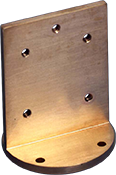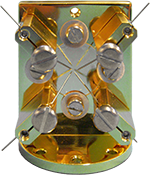Applications | High Tc
The critical temperature (Tc) of a superconducting material is the temperature at which it makes the transition from the normal state to the superconducting state. Modern research in high Tc superconductivity is mostly concentrated on materials with a Tc well above the boiling point of liquid nitrogen, so a cryostat that operates with LN2 is adequate for most high-Tc studies.
A popular method of characterizing a high Tc sample is simply performing a 4-point resistivity measurement as a function of temperature to find out where the superconducting transition occurs. Essentially any Lake Shore cryostat can be used for a resistivity measurement. The only accessories that are required are an electrical feedthrough and four wires to the sample area. To keep the operating cost as low as possible, the cryostat should work with liquid nitrogen.
High Tc materials are ceramics that tend to be poor thermal conductors. A system that cools the sample in flowing vapor or exchange gas would be better suited for cooling these types of samples than a system where the sample is cooled in a vacuum.
The Lake Shore VNF (works with LN2 only) and STVP (works with LN2 and LHe) cryostats are the most affordable variable-temperature systems that cool the sample in a flowing stream of LN2 for temperatures at 77 K and below, or LN2 vapor for temperatures between 77 K and 325 K. These are both top-loading cryostats that allow for rapid sample change without warming the cryostat to room temperature.
Some customers may prefer a cryostat that cools the sample in a vacuum environment. A VPF-100 or ST-100 would be the most affordable choice for cryostats with the sample cooled under a vacuum.
The VPF-100 and VNF-100 both have a small internal LN2 reservoir. The VPF-100 has a hold time of about 5 h at 77 K, and the VNF-100 has a hold time of about 6 to 8 h.
The ST-100 and STVP cryostats are continuous flow systems that are connected to a large external storage Dewar using a continuous flow transfer line during operation. They can operate as long as the Dewar has LN2.
Most studies on high-Tc samples are transport measurements and do not require optical access to the sample. Even though the VNF-100, STVP-100, VPF-100, and ST-100 are optical cryostats, they are lower in price than the non-optical versions because they are built in large quantities to keep the cost per unit as low as possible. These systems are also usually in stock and ready for fast delivery. The non-optical versions of these systems are custom-built, which results in a higher price and longer lead time.
Lake Shore offers several sample holders that may be useful in making 4-point resistivity measurements. The sample needs to be electrically isolated from the sample holder. The 4-probe sample holder includes a sapphire disc to accomplish this goal. The blank sample holder and the standard resistivity sample holder do not have any provision for electrical isolation, so the end-user needs to isolate the sample in some other way. A thin layer of VGE varnish will thermally anchor the sample to the sample holder and still provide electrical isolation.
Four electrical connections need to be made to the sample, so wires or cables with the appropriate electrical feedthrough need to be included on the cryostat. Twisted pair Phosphor-Bronze wires are the most commonly used wires for resistivity measurements. These wires can be installed to a standard 8-pin or 10-pin electrical feedthrough.
Lake Shore also offers ultraminiature coaxial cables that can be connected to SMA or BNC feedthroughs if shielded or high-frequency connections are required. We also offer ultraminiature triaxial cable and Trompeter triaxial feedthroughs for guarded measurements.
The exact types of installed wires or cables and electrical feedthroughs are usually determined by the type of instruments the customer is using to perform the electrical measurement. For example, if the instrument has BNC connections for the cable that links the instrument to the cryostat, then BNC feedthroughs on the cryostat with coaxial cables to the sample would probably be the best choice to optimize the performance of the instrument. However, twisted pair wires inside the cryostat may still be acceptable. We trust our customers to choose the best combination for their own particular measurements.
The superconducting transition can also be observed through magnetic measurements such as VSM (vibrating sample magnetometry), SQUID magnetometry, A/C susceptibility, and other measurements. Lake Shore makes a wide variety of open and closed-cycle cryostats that can be used with instruments from other vendors for these purposes.
The transition temperature of most high-Tc materials can be increased through the application of pressure to the sample. Diamond anvil cells (DACs) are commonly used for this purpose. In fact, the current world record for the highest transition temperature was achieved using a DAC. Commercially available DACs come in a wide variety of configurations. Lake Shore offers special cryostats and sample holders specially configured to interface with DACs from several popular vendors. Please refer to the DAC section in the applications area of the website for more details.
Determining the structure of High-Tc materials at low temperature is of great importance in characterizing and understanding these materials. Lake Shore offers custom cryostats for use in neutron scattering, x-ray diffraction, and other techniques.
High-Tc materials are also fabricated in thin films. Surface studies of these thin films are also of great interest. Lake Shore makes cryostats for use in STM, SEM, AFM, and other applications. Please refer to the applications section of the website for more information.
Existing designs include:
- Continuous flow cryostat with the sample located in vacuum — ST-100 Series cryostats
- Continuous flow cryostat with the sample located in vapor — STVP-100 Series cryostats
- Liquid nitrogen pourfill cryostat with the sample located in vacuum — VPF-100 Series cryostats
- Closed-cycle refrigerator with the sample located in vacuum — CCS-100 Series cryostats
Contact us today for details of how our systems can be integrated into your laboratory.





